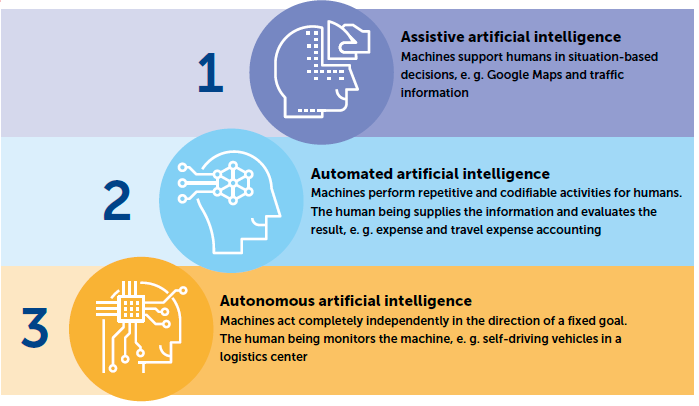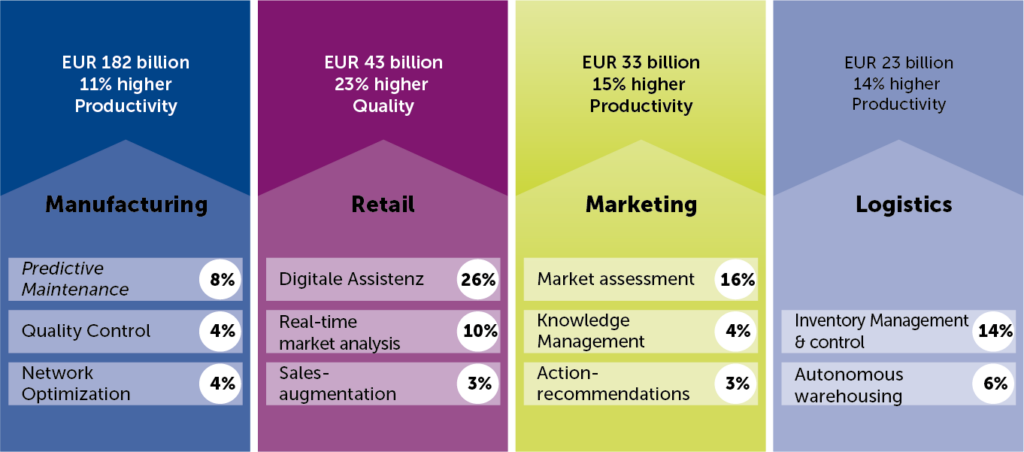What is AI and what impacts can we expect?
AI, in the simplest sense, is when machines replicate individual capabilities of humans. Today, AI solutions are mostly capabilities adapted to a specific problem. Examples are the optical inspection of goods for defect detection or the analysis of job application letters.

Fig. Overview of the fields of application of artificial intelligence – Source: Arthur D. Little, eco e. V
AI will influence the entire value chain and, in the long run, AI solutions will solve more than just pre-specified problems. The categories of AI:

Fig. The categories of AI – Source: Arthur D. Little, eco e. V.
For companies to be able to use AI successfully and thus generate sustainable benefits, four factors must be considered. AI is only a factor in two of these .
1. Which technology is AI based on?
AI is not a single technology, but consists of three essential building blocks that result in AI applications. This is a significant difference to other technologies that can be considered as single building blocks, such as database systems.
The building blocks for the development of AI applications are data (including databases), machine learning, and neural networks or analytical models. Only the combination of these can create AI applications. AI does not create any benefits at the exclusively technological level, unlike other technologies.
2. What are the benefits of AI?
The added value and benefits of AI arise from the practical application in business processes. We divide the added value into three areas: language recognition, image recognition, and logical reasoning. More than 150 specific AI applications are known to support business processes today. We assume that by 2025 one third – at least 50 specific applications – will be established in practice and will be part of normal operations. AI will support employees and increase the degree of automation in manual and repetitive activities by at least 50 percent. In addition to the technology and the benefits of AI, alasting successful deployment calls for conditions to be met in terms of the strategic change of companies and thecreation of legal framework conditions.
3. How can AI be implemented?
AI will have a direct or indirect impact on all business areas along the value chain. Enterprises should begin implementing AI application cases in 2020 to leverage the technology. This requires not just a pragmatic approach to the introduction of AI applications (and technology) but, in particular, an analysis of their structural impact. As is the case with digitalization, companies need to build the right competencies and adapt business processes and models for the long-term. This begins with the question of whether assets and capabilities in an “AI world” still allow differentiation between products and services. It also factors in aspects of future cooperation between humans and machines. This calls for innovative concepts for overarching governance and, in particular, ownership of data – two challenges familiar from digitalization and which have been resolved by very few companies. A more detailed outlook on the necessary strategic change is given in Chapter 5 .
4. What is the regulatory framework for AI?
The handling of AI and its impact on the state, society, and economy raise questions about the political, legal, and societal regulatory framework for AI. Chapter 6 presents the strategic approaches taken by governments and intergovernmental organizations on this issue.
The most important use cases of AI are :
In Manufacturing:
approx. 11 % higher productivity t
- Predictive maintenance
- Automation of quality control
- Optimization of the manufacturing network
In Logistics:
approx. 14 % higher productivity
- Automation of inventory management
- Autonomous warehouse
Im In Retail:
approx. 23 % higher effectiveness
- Support of sales staff through digital assistants
- Real-time market analysis
- Support for presentation and sales processes
In Marketing
approx. 15 % higher productivity
- Automation of market analysis
- Knowledge management
- Recommendations for action

Fig. The most important use cases – Source: Arthur D. Little, eco e. V.
Companies in Germany are therefore urged – regardless of size, industry, and competitive position – to start implementing and using AI in their business environment as soon as possible. Companies can orient themselves around four strategic options:
- AI in Sight: carrying out first pilot projects, developing competencies, and tracking the technology
- AI Strengthened: strengthening a company’s own value creation through process support and automation
- AI Transformed: enriching and transforming products, services, and value creation with AI
- AI Player: creating new business models through AI or by marketing the company’s own AI solutions .
New eco Study Investigates Economic Potential of Artificial Intelligence: Strong Growth Forecast by 2025
- Chance for Europe: Study shows potential of AI in Germany alone to generate approx. 488 billion Euros in 2025
- eco recommends that companies across the board should promptly introduce AI
- Alongside targeted research and development, politics must also support high-speed and sovereign digital infrastructures, as well as societal acceptance for AI
Technologies and applications based on artificial intelligence (AI) have an enormous economic potential. A joint study published today by eco – Association of the Internet Industry and Arthur D. Little and supported by the Vodafone Foundation, examines for the first time – on the basis of 150 examined use cases – what specific effects AI can be expected to bring for companies in Germany. The finding: If AI is implemented across the board in Germany, GDP growth of over 13 percent is realistic by 2025 (in comparison to 2019) – a result which, extrapolated out to the European context, vividly portrays the economic potential of this technology. For the German context, this corresponds to an overall potential of approx. 488 billion Euros. Of this, around 330 billion Euros (70%) will result from cost savings, and approx. 150 billion Euros (30%) from revenue potential across all sectors. The sectors Retail & Consumer and Energy, Environment & Chemicals will experience the greatest benefit, with each reaching just under 100 billion Euros. The authors see particularly large opportunities for Industry 4.0: At a little over 50 percent (182.5 billion Euros), the largest cost savings can be achieved through AI support for manufacturing. .
The study can be requested at international.eco.de/artificial-intelligence-its-potential-and-the-lasting-transformation-of-the-german-economy
The results of the AI study at a glance:
- AI is implemented across the board in Germany, GDP growth of over 13 percent is realistic by 2025 (in comparison to 2019).
- This corresponds to an overall potential of approx. 488 billion Euros (with an annual growth rate of approx. 34%). Of this, around 330 billion Euros (70%) will result from cost savings, and approx. 150 billion Euros (30%) from revenue potential across all sectors.
- Industry 4.0: At a little over 50 percent (182.5 billion Euros), the largest cost savings can be achieved through AI support for manufacturing.
- Significant impact expected for the sectors Retail & Consumer and Energy, Environment & Chemicals, with each reaching just under 100 billion Euros.
